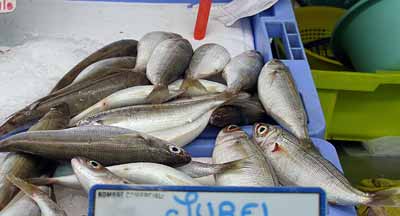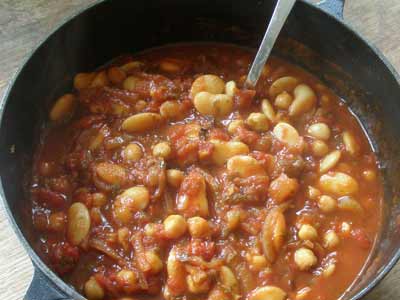Wels or sheetfish. A type of catfish that can grow up to 5 m (16 ft) in the wild and is Europe's largest freshwater. It is found in the Rhine River in Germany eastwards to the Black and Caspian Seas. The elongated wels body consists of a powerful forebody and a laterally greatly compressed tail shaft; the prominent anal fin merges with the caudal fin. This fish, with its calm undulating tail movements normally has its long pair of upper jaw barbels pointing straight forward, while the four smaller barbels of the lower lip hang down. The dorsal fin, consisting of just four rays, seems small for such a powerful animal. In the wild they have been known to eat ducks where they rush up behind them at night, sucking them into their mouths with a vortex motion. In their native habitat they feed on other fishes mainly eels, burbot, tench and roach, but it also takes water voles.

Boops or bogue, an inferior variety of sea bream. These are brightly coloured, silvery yellow, spindle-shaped fish with large eyes abundant in the Mediterranean about 20-30 cm (8-12 inches) long. They are usually used in fish soups or are served grilled.

A stew of butter beans and tomato sauce with onions. In Alonissos, yígantes was one of the dishes which Kiria Maria made on a regular basis as a warming winter supper. Hers included a generous amount of chopped mint in the recipe which really added to the flavour.
"White fish." Sneep. A gregarious relation of the carp. It is found in the upper reaches of rivers, where it likes fast-moving water so may be found around piers or bridges of where currents speed around obstructions in the water. Its mouth is designed for scraping algal growths from stones. The flesh is tasty but has many bones which discourages people from eating it.
Wels or sheetfish. A type of catfish that can grow up to 5 m (16 ft) in the wild and is Europe's largest freshwater. It is found in the Rhine River in Germany eastwards to the Black and Caspian Seas. The elongated wels body consists of a powerful forebody and a laterally greatly compressed tail shaft; the prominent anal fin merges with the caudal fin. This fish, with its calm undulating tail movements normally has its long pair of upper jaw barbels pointing straight forward, while the four smaller barbels of the lower lip hang down. The dorsal fin, consisting of just four rays, seems small for such a powerful animal. In the wild they have been known to eat ducks where they rush up behind them at night, sucking them into their mouths with a vortex motion. In their native habitat they feed on other fishes mainly eels, burbot, tench and roach, but it also takes water voles.
Wels or sheetfish. A type of catfish that can grow up to 5 m (16 ft) in the wild and is Europe's largest freshwater. It is found in the Rhine River in Germany eastwards to the Black and Caspian Seas. The elongated wels body consists of a powerful forebody and a laterally greatly compressed tail shaft; the prominent anal fin merges with the caudal fin. This fish, with its calm undulating tail movements normally has its long pair of upper jaw barbels pointing straight forward, while the four smaller barbels of the lower lip hang down. The dorsal fin, consisting of just four rays, seems small for such a powerful animal. In the wild they have been known to eat ducks where they rush up behind them at night, sucking them into their mouths with a vortex motion. In their native habitat they feed on other fishes mainly eels, burbot, tench and roach, but it also takes water voles.
Wels or sheetfish. A type of catfish that can grow up to 5 m (16 ft) in the wild and is Europe's largest freshwater. It is found in the Rhine River in Germany eastwards to the Black and Caspian Seas. The elongated wels body consists of a powerful forebody and a laterally greatly compressed tail shaft; the prominent anal fin merges with the caudal fin. This fish, with its calm undulating tail movements normally has its long pair of upper jaw barbels pointing straight forward, while the four smaller barbels of the lower lip hang down. The dorsal fin, consisting of just four rays, seems small for such a powerful animal. In the wild they have been known to eat ducks where they rush up behind them at night, sucking them into their mouths with a vortex motion. In their native habitat they feed on other fishes mainly eels, burbot, tench and roach, but it also takes water voles.